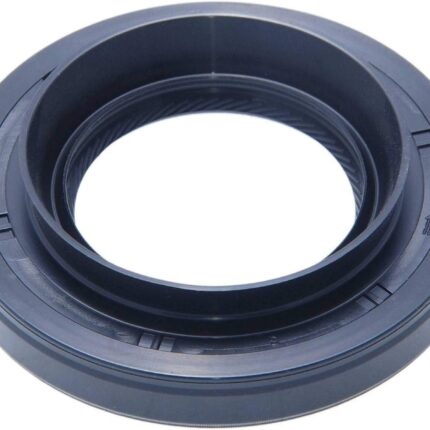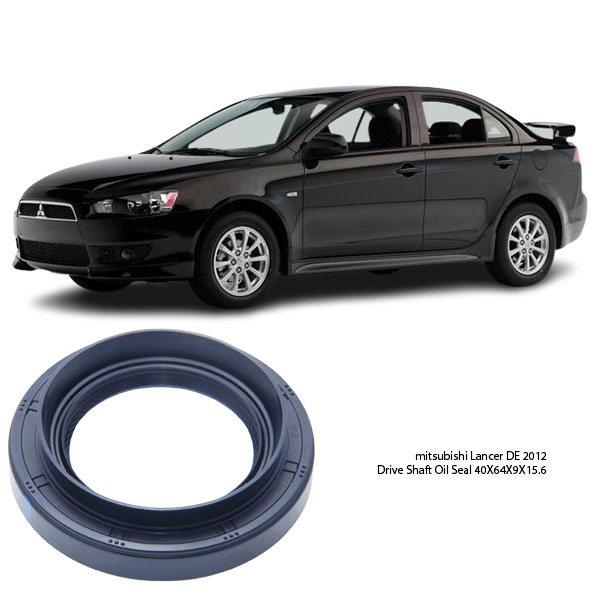-20%
Get Mitsubishi Lancer DE 2012 Drive Shaft Oil Seal 40X64X9X15.6 in Kenya
The drive shaft oil seal, also known as the axle seal, is a critical component located at the point where the drive shaft exits the transmission or differential housing. Its primary function is to prevent transmission fluid or differential oil from leaking out of the transmission or differential, while also keeping contaminants such as dirt, dust, and water out of the internal components. Here’s a detailed overview of its functions, signs of wear or failure, and maintenance considerations:
Functions of Drive Shaft Oil Seal
- Fluid Containment
- Primary Function: Seal the point where the drive shaft exits the transmission or differential housing to prevent fluid leaks.
- Details: The oil seal is designed to withstand the pressure of transmission fluid or differential oil while maintaining a tight seal around the rotating drive shaft.
- Contaminant Protection
- Primary Function: Prevent dirt, dust, water, and other contaminants from entering the transmission or differential.
- Details: The seal’s design includes a lip or sealing edge that prevents external contaminants from compromising the internal lubrication and components.
Signs of Worn or Failing Drive Shaft Oil Seal
-
- Fluid Leaks
- Description: Visible oil or fluid leaks around the area where the drive shaft exits the transmission or differential.
- Details: A primary indicator of a failing oil seal is the presence of fluid leaks under the vehicle, particularly noticeable after it has been parked. Transmission fluid or differential oil may appear as dark or reddish-brown puddles or spots on the ground.
- Low Fluid Levels
- Description: Decreased levels of transmission fluid or differential oil.
- Details: As the oil seal deteriorates and begins to leak, it can lead to a gradual decrease in fluid levels within the transmission or differential. This may trigger warning lights on the dashboard or require more frequent fluid top-offs.
- Visible Contamination
- Description: Contaminated transmission fluid or differential oil.
- Details: A failing oil seal can allow external contaminants such as dirt, dust, and water to enter the transmission or differential housing. This contamination can cause the fluid to appear darker in color or have a milky appearance, indicating the presence of water.
- Burning Smell
- Description: A noticeable burning odor coming from underneath the vehicle or near the transmission.
- Details: If transmission fluid leaks onto hot engine components or exhaust parts due to a failing oil seal, it can produce a distinct burning smell as the fluid evaporates upon contact with the heat.
- Unusual Noise
- Description: Whining or grinding noises from the transmission or differential.
- Details: In severe cases where the oil seal has completely failed, the lack of adequate lubrication can lead to increased friction and wear within the transmission or differential components. This can result in abnormal noises during operation, especially when accelerating or decelerating.
- Difficulty Shifting Gears
- Description: Problems with shifting gears, such as slipping or hesitation.
- Details: Insufficient transmission fluid due to a leaking oil seal can affect hydraulic pressure and lubrication within the transmission. This can cause difficulty in engaging gears smoothly, leading to erratic shifting patterns or hesitation.
- Visible Seal Damage
- Description: Inspection reveals physical damage to the oil seal, such as cracks, tears, or distortion.
- Details: Over time, the rubber or elastomer material of the oil seal can degrade due to heat, age, or exposure to contaminants. Visual inspection of the seal during routine maintenance checks can reveal signs of wear that may necessitate replacement.
Importance of Addressing Worn Drive Shaft Oil Seal
Promptly addressing signs of a worn or failing drive shaft oil seal is crucial for several reasons:
- Prevent Fluid Loss: Leaking transmission fluid or differential oil can lead to decreased lubrication and potential damage to internal components.
- Maintain Fluid Levels: Proper fluid levels are essential for the smooth operation and longevity of the transmission or differential.
- Prevent Contamination: Keeping contaminants out of the transmission or differential helps preserve the integrity of the fluid and internal components.
- Avoid Costly Repairs: Early detection and replacement of a failing oil seal can prevent more extensive damage to the transmission or differential, which could require costly repairs or replacement.
Maintenance and Replacement
To ensure optimal performance and reliability:
- Regular Inspection: Include inspection of the drive shaft oil seal during routine maintenance checks or whenever fluid leaks are suspected.
- Quality Replacement: Use high-quality replacement seals that meet or exceed the specifications of your vehicle’s transmission or differential.
- Professional Service: Consider having a qualified mechanic perform the replacement, as accessing and replacing the oil seal may require specialized tools and expertise.
- Check Surrounding Components: While replacing the oil seal, inspect surrounding components such as the drive shaft, CV joints, and differential housing for any signs of wear or damage.
- Fluid Leaks
Follow us on Facebook for more parts.




